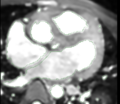Difference between revisions of "2014 Project Week:CardiacCongenitalSegmentation"
From NAMIC Wiki
| Line 3: | Line 3: | ||
Image:PW-SLC2014.png|[[2014_Winter_Project_Week#Projects|Projects List]] | Image:PW-SLC2014.png|[[2014_Winter_Project_Week#Projects|Projects List]] | ||
Image:Normal_vs_DORV_lrg.gif|Double outlet right ventricle | Image:Normal_vs_DORV_lrg.gif|Double outlet right ventricle | ||
| + | Image:carreraScribbles.png|Example input to Carrera on axial slice | ||
| + | Image:carreraOutput.png|Carrera output after manual interaction | ||
</gallery> | </gallery> | ||
Revision as of 15:14, 10 January 2014
Home < 2014 Project Week:CardiacCongenitalSegmentationKey Investigators
Danielle Pace, MIT
Polina Golland, MIT
Project Description
Objective
- Develop a semi-automatic segmentation algorithm for cardiac MR images of patients with congenital heart defects.
- Goal is to build a surface model showing the endocardial and epicardial boundaries, for surgical planning.
- Challenges:
- Very large inter-subject variability due to heart defects
- Intensity inhomogeneities within myocardium and blood pool
- Similar intensity distributions within adjacent tissues (e.g. liver, chest muscle)
Approach, Plan
- Try existing open-source tools for segmentation and registration on the five datasets that we have so far.
- See where these methods fail, to focus our efforts for developing algorithms for segmenting hearts with congenital defects.
Progress
- Focused on blood pool segmentation in one test case. Tried:
- CARMA tools: isolated connected / connected threshold operators
- Editor level tracing effect
- Editor Fast Marching effect
- Editor Grow Cuts effect
- Carrera interactive segmentation
- Robust statistic active contour segmentation
- Best tool = Carrera interactive segmentation
- Main difficulty = small chamber/vessel walls assigned as blood pool, but these can be fixed within Carrera somewhat easily
- Also tried affine registrations across my 5 subjects, using BRAINSFIT
- Works very roughly, as expected
- Thanks to: Josh Cates, Salma Bengali, Yi Gao, Ivan Kolesov for your help and suggestions!



